G|Code House design charrette
Incubator at Sasaki
Explore the research from our 2018 Sasaki Foundation Design Grants research teams below, and learn more in our 2018-2019 Design Grants Research publication.
2018 Research Teams
Charles River Floating Wetland
Proactive Approaches to Climate Adaptation
Laura Jasinski, Vanessa Nason, Max Rome, Pennie Taylor
By installing a floating wetland on the Charles River, the team plans to create a visually impactful statement about missing habitat, to engage the public in an important conversation about the relationship between ecology, pollution, and water quality, and to conduct unique research that can be used to design and size future installations in order to curb harmful algal blooms through increased herbivorous control.
The Charles River Floating Wetland, an initiative of the Charles River Conservancy (CRC), will be the first project of its kind in Greater Boston. An important aspect of this project is the role that it will play in informing future work by serving as a case study for designers and river advocates and as a point of reference for regulators unfamiliar with a project that does not fit easily within the typical permit process.
The floating wetland island will be assembled from self-buoyant modules, which will be roughly 57 feet by 19 feet when assembled and will be anchored to the bottom of the river. The island will be planted with a variety of native wetland plants. Those plants will grow through the matrix, their roots reaching into the water to serve as additional habitat for microscopic zooplankton. A research program will examine whether the additional habitat has a meaningful impact on zooplankton species distribution and size. Because zooplankton can be efficient grazers of cyanobacteria, supporting their population could provide another tool for controlling harmful algal blooms.
On a fundamental level, the health of the Charles River is an issue of equity. As recently as the 1950s, the banks of the Charles River were a public space where, during the hottest days of the summer, families of all incomes and backgrounds gathered to swim and cool down. The hope is that this project will contribute to the restoration of the Charles River and that this installation will help visitors to imagine a future in which plantings and restored ecology lead the way to a river that is healthy, safe, and swimmable.
Visit the project’s webpage and learn more about the Charles River Conservancy.
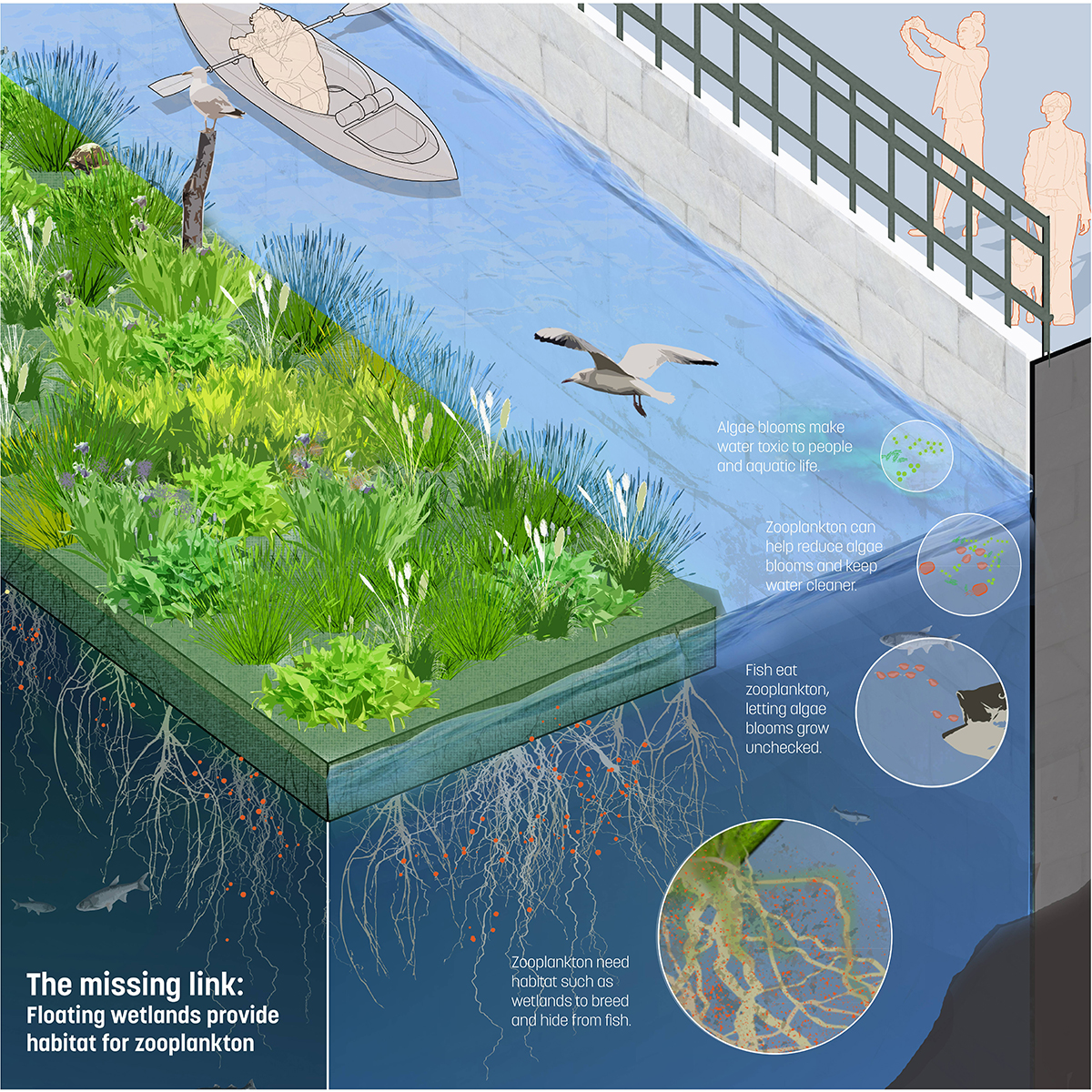
Charles River Floating Wetland concept graphic
Image courtesy Charles River Floating Wetland in partnership with Sasaki
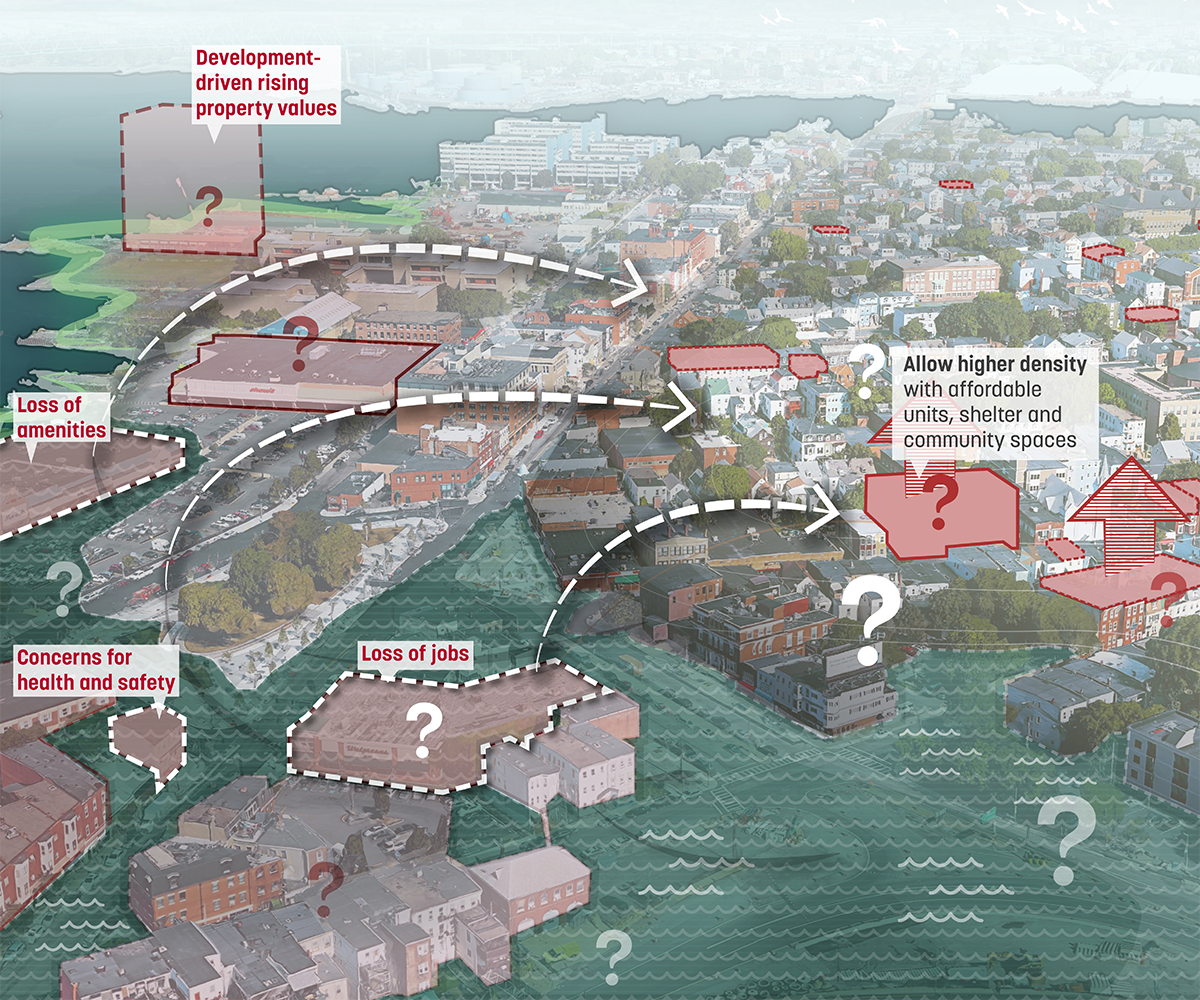
Eastie for Eastie concept graphic
Image courtesy Eastie for Eastie in partnership with Sasaki
Eastie for Eastie
Proactive Approaches to Climate Adaptation
New Models for Housing
Collyn Chan, Mario Giampieri, Kelly Main, Kannan Thiruvengadam
Traditional managed retreat projects do not often take into consideration community coherence or community agency in redesigning the coastline. A community-based managed retreat dialogue and design process is a viable first step in climate adaptation. Eastie for Eastie (E4E) is a project between community partners and urban planners to co-create a toolkit to discuss long-term climate impacts and managed retreat in East Boston.
The toolkit employs a combination of digital and analog tools such as interactive models, web mapping, and games to give community members the opportunity to experiment with the physical and spatial consequences of adaptation strategies. Adaptation scenarios are further developed through engagement workshops that focus on pathways to implementation, as well as the costs and opportunities of such actions.
E4E co-creates best practices to help guide community understanding and build power to act on the long-term effects of climate change on current and future life in East Boston.
Visit the project website and learn more about the project’s community partner Eastie Farm.
The ECHOLocator: Expanding Choice in Housing Opportunities
New Models for Housing
Innovation in Transit and Access to Mobility Choices
Nicholas Kelly, Anson Stewart, Robert Terrell
The ECHOLocator project—ECHO stands for Expanding Choice in Housing Opportunities—is a new digital tool in development to help improve information on neighborhoods available to low-income families in Massachusetts. Motivated by research that neighborhoods can profoundly affect the outcomes of low-income children, this tool is inspired by the idea that improved information on neighborhoods can help break the cycle of intergenerational poverty.
Evidence has never been stronger in support of the fact that where individuals grow up strongly affects their life opportunities. The housing choice voucher program provides subsidies to five million Americans and represents a powerful, yet mostly untapped, mechanism for reducing inequality by enabling low-income individuals to access neighborhoods that provide increased opportunities for their children. However, voucher holders are frequently barred from doing so due to unaffordable rents, expensive or nonexistent transit, informational shortfalls, and a rightful desire to remain connected to their communities.
Designed in conjunction with MIT, the Boston Housing Authority (BHA), and Conveyal, the ECHOLocator uses the latest in transportation analytics in combination with cutting edge data on neighborhoods to help low-income families using housing choice vouchers navigate neighborhoods within Boston and the Greater Boston area. As the first housing search tool of its kind, the ECHOLocator will hopefully provide a new interdisciplinary platform for other housing authorities to adopt in order to empower low-income families across the state and across the country.
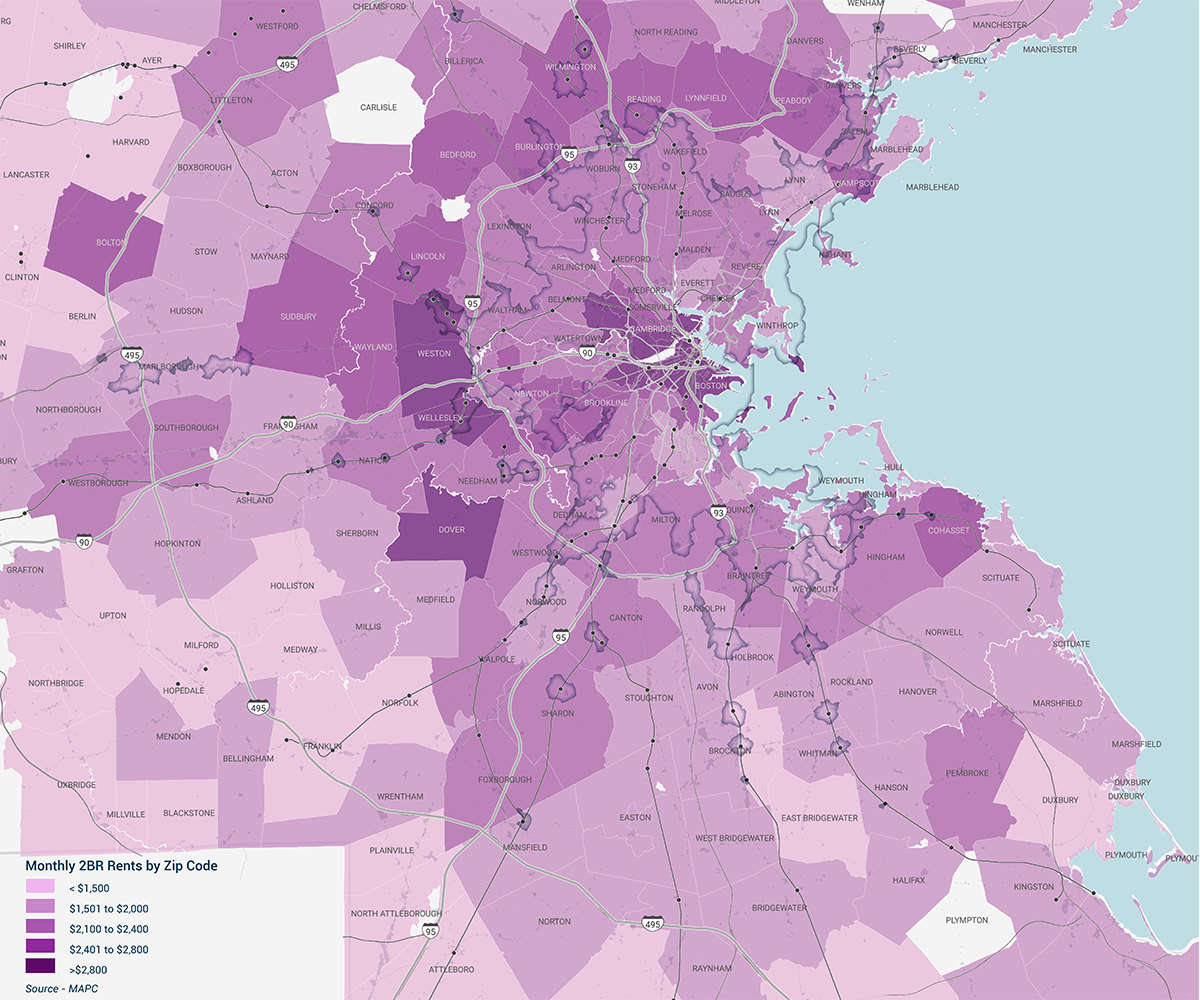
Map of monthly two-bedroom rents by zip code
Image courtesy the ECHOLocator in partnerwhip with Sasaki
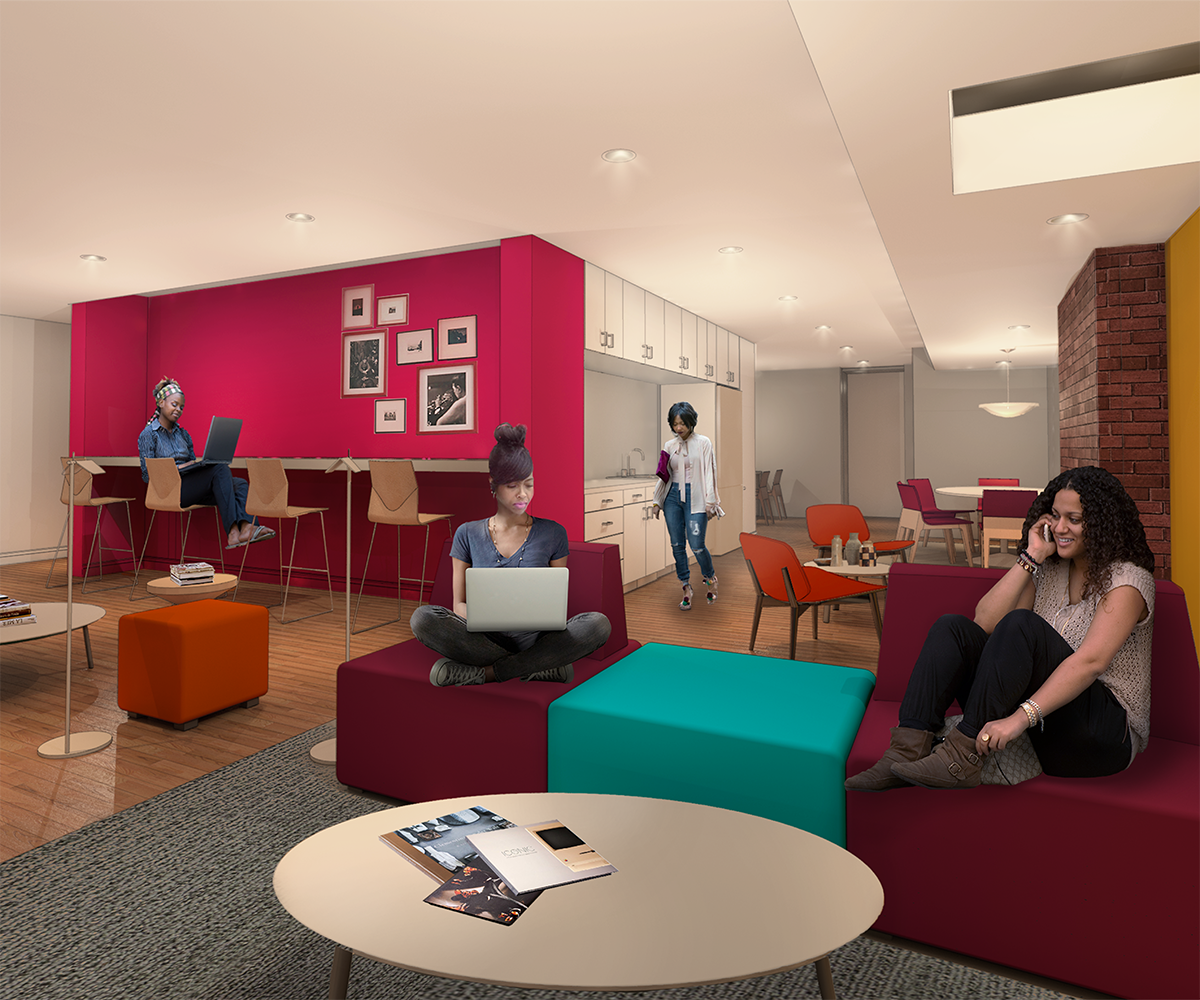
Rendering of G{Code} House basement
Image courtesy Sasaki
G{Code} House
New Models for Housing
Creative Community Building
Rizel Bobb-Semple, Lindsay Nuon, Bridgette Wallace
G{Code} House is an innovative co-living, -learning, and -working incubator based in Roxbury, Massachusetts, dedicated to providing young women of color between the ages of 18 and 25 with the tools they need to succeed in today’s business world. G{Code} aims to produce change makers who are not only ready to make an impact in their careers, but are prepared to be leaders, innovators, and young women who collectively advance to make a difference in their communities.
The crossroads at which many girls find themselves after graduating from high school can be intimidating and confusing, and for many young women of color, securing food, shelter, and safety often takes precedence over pursuing post-secondary schooling or careers.
As a proposed pilot program, G{Code} House is designed to help young women of color who have an interest and/or aptitude for computers or technology, but do not know how to develop their interest or understand the opportunities. G{Code}’s co-living environment helps address many challenges these young women face, such as housing insecurity, access to post-secondary education, and placement support, while helping to minimize outside distractions. The program consists of nine months of in-class training, six months of an internship/co-op, and nine months of specialty training.
By collaborating with industry partners, these young women will have opportunities for internships and entry-level jobs, and will be better prepared if they choose to attend a four-year college. In addition to learning cutting-edge technology skills and gaining employment, they will find support, mentoring, and counseling in a safe, focused home.
Please Touch the Art
Creative Community Building
Karissa Coady, Sandra Jaffe, Matt Jatkola, Georgina Kleege, Tanja Milojevic, Aneleise Ruggles
Presented by the Mosesian Center for the Arts, Please Touch the Art is a multi-sensory exhibition aimed at creating an immersive artistic experience that engages all of the senses. Not only does Please Touch the Art challenge visitors to consider how they may engage with a work of art beyond seeing, it also challenges visual artists to consider how their work engages a diverse range of audience members.
Also included in this project is a History of Blind Accessibility in the Arts exhibit, which features a selection of artifacts and imagery related to over a century of innovation, adaptation, and inclusion. Please Touch the Art invites sighted and visually impaired visitors to go beyond looking at artwork and encourages them to engage their other senses to experience each piece. The exhibit addresses issues about the nature of aesthetic appreciation and perception of art. It also provides an inclusive and accessible experience for all visitors with the use of braille and large-print gallery guides, audio guides, tactile maps, and navigational tools.
Creating a more inclusive and accessible model for the Mosesian Center’s operations has greater implications beyond having a successful Please Touch the Art exhibition. The Mosesian Center is committed to continuing to make considerations for both its facilities and its programming to ensure anyone who enters the front door is valued, respected, and has equal artistic resources available to them.
Visit the exhibition webpage and learn more about the Mosesian Center for the Arts.
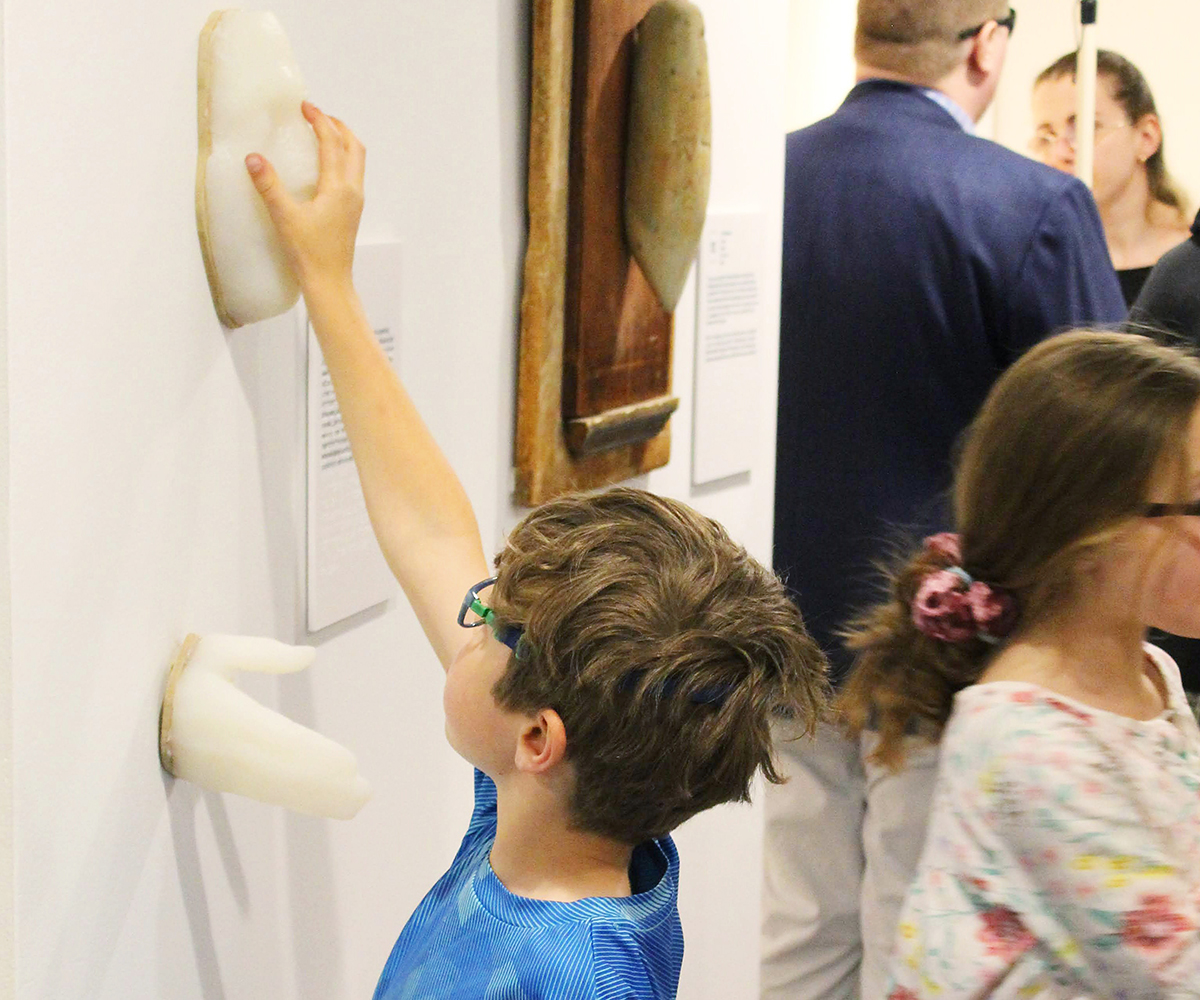
Child touching art
Photo courtesy Rachel E. Casey
